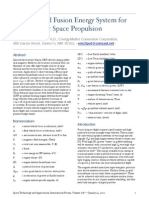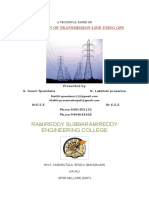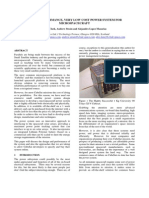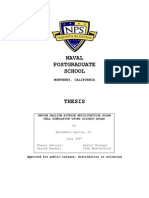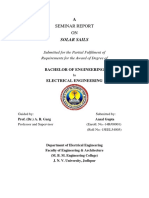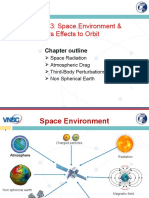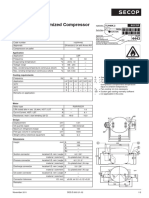SBSP
SBSP
Uploaded by
Sathwik CMCopyright:
Available Formats
SBSP
SBSP
Uploaded by
Sathwik CMOriginal Description:
Copyright
Available Formats
Share this document
Did you find this document useful?
Is this content inappropriate?
Copyright:
Available Formats
SBSP
SBSP
Uploaded by
Sathwik CMCopyright:
Available Formats
SPACE-BASED SOLAR POWER
MANASWI GOWRAVAJHALA
KASTURI AISHANI
11311A0439
11311A0402
ECE-C1
ECE-C1
Abstract- Space-based solar power (SBSP) is the concept of
collecting solar power in space for use on Earth. It has been
in research since the early 1970s. In space, transmission of
solar
energy
is
unaffected
by
the
filtering
effects
of atmospheric gases. Consequently, collection in orbit is
approximately 144% of the maximum attainable on Earth's
surface. SBSP designs generally include a collecting satellite
that could possibly direct power on demand to different
surface locations based on geographical baseload or peak
load power needs and some manner of wireless power
transmission. The collecting satellite would convert solar
energy
into
electrical
energy
on
board,
powering
Solar energy refers primarily to the use of solar
radiation for practical ends. Solar technologies are broadly
characterized as either passive or active depending on the way
they capture, convert and distribute sunlight. Active solar
techniques use photovoltaic panels, pumps, and fans to convert
sunlight into useful outputs. Passive solar techniques include
selecting materials with favorable thermal properties, designing
spaces that naturally circulate air, and referencing the position
of a building to the Sun. Active solar technologies increase the
supply of energy and are considered supply side technologies,
while passive solar technologies reduce the need for alternate
resources and are generally considered demand side
technologies .One such technology is SBSP.
a microwave transmitter or laser emitter, and focus its beam
toward a collector (rectenna) on the Earth's surface. The
collecting satellite would reside well outside of any
atmospheric gasses, cloud cover, wind, and other weather
events thus eliminating all weather concerns. Radio waves
can benefit the welfare of humanity through other purposes
than communications. Microwave power transmission (MPT)
is one of the new technological frontiers. Solar power
satellites (SPS) will provide a clean and limitless energy
resource from space through this technique. This article
answers the fundamental question of why we need to develop
SPS from the viewpoint of critical global issues for mankind.
It then reviews SPS research, mainly in Japan, in the 1980s
and
1990s.
These
efforts
include
two
MPT rocket
experiments; a microwave-driven airplane experiment; and
Fig.1The concept of SBSP transmission on to earth
MPT technology developments, concepts, and systems studies
of SPS.
I.INTRODUCTION
In physics, energy is an indirectly observed quantity that is
often understood as the ability of a physical system to
do work on other physical systems .There are several forms of
energy such as electric energy, magnetic energy, mechanical
energy ,nuclear energy, ,solar energy. Solar energy meaning
energy from the sun has been harnessed by humans since
ancient times using a range of ever-evolving technologies.
Space-based solar power (SBSP) is the concept of
collecting solar power in space for use on Earth It has been in
research since the early 1970s.SBSP would differ from current
solar collection methods in that the means used to collect
energy would reside on an orbiting satellite instead of on
Earth's surface. Thus the satellite used here is solar power
satellites. Solar Power Satellites (SPS) converts solar energy in
to micro waves and sends that microwaves in to a beam to a
receiving antenna on the Earth for conversion to ordinary
electricity. The concept of a large SPS that would be placed in
geostationary orbit was invented by Peter Glaser in 1968. The
SPS concept was examined extensively during the late 1970s
by the U.S Department of Energy (DOE) and the National
Aeronautics and Space Administration (NASA). The DOENASA put forward the SPS Reference System Concept in
1979. SBSP designs generally include the use of some manner
of wireless power transmission. The collecting satellite would
convert solar energy into electrical energy on board, powering
a microwave transmitter or laser emitter, and focus its beam
toward a collector rectenna on the Earth's surface.
II.SOLAR POWER SATELLITES
SPS is a clean, large-scale, stable electric
power source. Solar Power Satellites is known by a variety of
other names such as Satellite Power System, Space Power
Station, Space Power System, Solar Power Station, Space Solar
Power Station etc. One of the key technologies needed to
enable the future feasibility of SPS is that of Microwave
Wireless Power Transmission .WPT is based on the energy
transfer capacity of microwave beam i.e, energy can be
transmitted by a well focused microwave beam. Advances in
Phased array antennas and rectennas have provided the
building blocks for a realizable WPT system.
terrorist attacks on Earth bound nuclear power plants have
intensified environmentalist opposition to nuclear power.
Moreover, switching on to the natural fission reactor, the sun,
yields energy with no waste products. Earth based solar panels
receives only a part of the solar energy. It will be affected by
the day & night effect and other factors such as clouds. So it is
desirable to place the solar panel in the space itself, where, the
solar energy is collected and converted in to electricity which is
then converted to a highly directed microwave beam for
transmission. This microwave beam, which can be directed to
any desired location on Earth surface, can be collected and then
converted back to electricity. This concept is more
advantageous than conventional methods. Also the microwave
energy, chosen for transmission, can pass unimpeded through
clouds and precipitations.
III.DESIGN
Space-based solar power essentially consists of three
elements:
a means of collecting solar power in space, for
example via solar cells or a heat engine
a means of transmitting power to earth, for example
via microwave or laser
a means of receiving power on earth, for example via
a microwave antenna (rectenna)
Fig.2The Solar Power Satellite used in SBSP transmission
Increasing global energy demand is likely to continue for many
decades. Renewable energy is a compelling approach - both
philosophically and in engineering terms. However, many
renewable energy sources are limited in their ability to
affordably provide the base load power required for global
industrial development and prosperity, because of inherent land
and water requirements. The burning of fossil fuels resulted in
an abrupt decrease in their .it also led to the green house effect
and many other environmental problems. Nuclear power seems
to be an answer for global warming, but concerns about
Fig.3 Summary of Space based solar power
The space-based portion will not need to support itself against
gravity (other than relatively weak tidal stresses). It needs no
protection from terrestrial wind or weather, but will have to
cope with space hazards such as micro meteors and solar flares.
Two basic methods of conversion have been studied:
photovoltaic (PV) and solar dynamic (SD). Photovoltaic
conversion uses semiconductor cells to directly convert
photons into electrical power. Solar dynamic uses mirrors to
concentrate light on a boiler. The use of solar dynamic could
reduce mass par watt. Most analyses of SBSP have focused on
photovoltaic conversion (commonly known as solar cells).
surface. This is done using microwave transmission. Solar
power from the satellite is sent to Earth using a microwave
transmitter. Microwave transmission refers to the technology
of transmitting information or energy by the use of radio
waves whose wavelengths are conveniently measured in small
numbers of centimeter ; these are called microwaves. This part
of the radio spectrum ranges across frequencies of roughly
1.0 gigahertz (GHz) to 30 GHz. These correspond to
wavelengths from 30 centimeters down to 1.0 cm. after
transmission, the power is received by an antenna called
rectenna.
Wireless power transmission was proposed early on as a means
to transfer energy from collection to the Earth's surface, using
either microwave or laser radiation at a variety of frequencies.
IV.WORKING
Initially energy has to be collected from the sun using
a solar cell. A solar cell is an electrical device that converts the
energy of light directly into electricity by the photovoltaic
effect. It works in three steps. Firstly, Photons in sunlight hit
the solar panel and are absorbed by semiconducting materials,
such as silicon .Secondly electrons (negatively charged) are
knocked loose from their atoms, causing an electric potential
difference. Current starts flowing through
the material
toof
cancel
Fig.5
An array
microwave power transmitters set up on Haleakala for the power beam
the potential and this electricity is captured. Due to the special
composition of solar cells, the electrons are only allowed to
move in a single direction .Thirdly an array of solar cells
converts solar energy into a usable amount of direct current
(DC) electricity.
Fig.6 Rectenna used to convert microwave energy to current electricity
Fig.4 Solar panel to collect solar energy
Now the energy from the solar cell has to be
transmitted o earths surface. This consists of two parts i.e
transmitting power to earth and receiving power on the earths
A rectenna is a rectifying antenna, a special type
of antenna that is used to convert microwave energy into direct
current electricity. They are used in wireless power
transmission systems that transmit power by radio waves. A
simple rectenna element consists of a dipole antenna with an
RF diode connected across the dipole elements. The
diode rectifies the AC current induced in the antenna by the
microwaves, to produce DC power, which powers a load
connected across the diode. Schottky diodes are usually used
because they have the lowest voltage drop and highest speed
and therefore have the lowest power losses due to conduction
and switching. Large rectennas consist of an array of many
such dipole elements.
Elimination of weather concerns, since the collecting
satellite would reside well outside of any atmospheric
gasses, cloud cover, wind, and other weather events.
Elimination of plant and wildlife interference.
Redirectable power transmission: A collecting satellite
could possibly direct power on demand to different
surface locations based on geographical baseload or
peak load power needs.
VI.CONCLUSION
V.ADVANTAGES
The SBSP concept is attractive because space has several
major advantages over the Earth's surface for the collection of
solar power.
There is no air in space, so the collecting surfaces
could receive much more intense sunlight,
unobstructed by weather.
A satellite could be illuminated over 99% of the time,
and be in Earth's shadow on only 75 minutes per night
at the spring and fall equinoxes.[29]
From the above information it is clear that this
technique is very much better. Moreover in the past few years,
it has been showing positive results. The reasons include
longer collection period and elimination of weather concerns,
since the collecting satellite would reside well outside of any
atmospheric gasses, cloud cover, wind, and other weather
events.
VII.REFERENCES
[1]
Relatively quick redirecting of power directly to areas
that need it most.
Higher collection rate: In space, transmission of solar
energy is unaffected by the filtering effects of
atmospheric gasses. Consequently, collection in orbit
is approximately 144% of the maximum attainable on
Earth's surface.
Longer collection period: Orbiting satellites can be
exposed to a consistently high degree of solar
radiation, generally for 24 hours per day, whereas
surface panels can collect for 12 hours per day at
most.[1]
http://en.wikipedia.org/wiki/Space-
based_solar_power
[2] Researchers Beam Space Solar Power
in Hawaii by Loretta Hidalgo, September
12, 2008.
[3] Wireless Power Transmission for Solar
Power Satellite (SPS) (Second Draft by N.
Shinohara), Space Solar Power Workshop,
Georgia Institute of Technology
You might also like
- Solar Power AircraftDocument16 pagesSolar Power Aircraftsafal shaNo ratings yet
- Design and Implementation of An Effective Electrical Power System For Nano Satellite 2Document7 pagesDesign and Implementation of An Effective Electrical Power System For Nano Satellite 2Mohammad Chessab MahdiNo ratings yet
- Advanced Fusion Energy SystemDocument11 pagesAdvanced Fusion Energy SystemPhilip KadickNo ratings yet
- Molecular DockingDocument64 pagesMolecular DockingQuty Papa KannaNo ratings yet
- Space Based Solar PowerDocument18 pagesSpace Based Solar PowerLord_JoelNo ratings yet
- Space-Based Solar PowerDocument13 pagesSpace-Based Solar PowerswathiNo ratings yet
- Solar Power SatelliteDocument28 pagesSolar Power SatelliteInduchoodan Rajendran100% (2)
- Space Based Solar PowerDocument5 pagesSpace Based Solar PowerHarshit SinghalNo ratings yet
- Wireless Power Transmission Via Solar Power SatelliteDocument16 pagesWireless Power Transmission Via Solar Power SatelliteAarthiNo ratings yet
- Wireless Power TransmissionDocument24 pagesWireless Power TransmissionSandeep MedishettyNo ratings yet
- Space-Based Solar PowerDocument25 pagesSpace-Based Solar PowerRishi UniyalNo ratings yet
- Space Based Solar PowerDocument40 pagesSpace Based Solar PowershwetajhambNo ratings yet
- Solar CellDocument33 pagesSolar CellSumit BansalNo ratings yet
- Chapter 1-Literature Survey 1.1Document41 pagesChapter 1-Literature Survey 1.1Abdul WaliNo ratings yet
- Protection of Transmission Line Using GPSDocument11 pagesProtection of Transmission Line Using GPSRohit GandhiNo ratings yet
- Solar Cell Fundamentals: SJSU Short Course D. W. ParentDocument9 pagesSolar Cell Fundamentals: SJSU Short Course D. W. ParentFaiz RangariNo ratings yet
- A Presentation ON: Submitted By:-Renu MeenaDocument10 pagesA Presentation ON: Submitted By:-Renu MeenaDinesh MeenaNo ratings yet
- A Project Report On: Single Axis Solar TrackerDocument47 pagesA Project Report On: Single Axis Solar TrackerzizoNo ratings yet
- A High Performance Very Low Cost Power System For MicrospacecraftDocument11 pagesA High Performance Very Low Cost Power System For MicrospacecraftpulaoNo ratings yet
- A 470036Document113 pagesA 470036Mamoona BashirNo ratings yet
- Btech EEE Major Project Report On Automatic Solar Tracking SystemDocument31 pagesBtech EEE Major Project Report On Automatic Solar Tracking System12deep2001No ratings yet
- Seminar ReportDocument102 pagesSeminar ReportRahul Bhardwaj67% (3)
- Solar Energy and ApplicationsDocument20 pagesSolar Energy and ApplicationsSanath ReddyNo ratings yet
- Seminar On Solar Mobile Charger: Submitted To: Submitted byDocument16 pagesSeminar On Solar Mobile Charger: Submitted To: Submitted byAkhila GottemukkulaNo ratings yet
- Energy From OceanDocument27 pagesEnergy From OceankaduNo ratings yet
- 271 - PH8252 Physics For Information Science - Notes UNIT IV OPTICAL PROPERTIES OF MATERIALS PDFDocument66 pages271 - PH8252 Physics For Information Science - Notes UNIT IV OPTICAL PROPERTIES OF MATERIALS PDFHari100% (1)
- Report On Solar Sun SeekerDocument35 pagesReport On Solar Sun SeekerpawantwrNo ratings yet
- First Page of AssignmentDocument8 pagesFirst Page of Assignmentmatougabouzmila0% (1)
- Solar Photovoltaic Fed Transzsi-Dvr For Power Quality Improvement of Grid-Connected PV SystemsDocument53 pagesSolar Photovoltaic Fed Transzsi-Dvr For Power Quality Improvement of Grid-Connected PV SystemsmoyyeenuddinNo ratings yet
- AutomaticSolarTracking 1Document17 pagesAutomaticSolarTracking 1Mohammed A100% (1)
- Power System of ESMO PDFDocument12 pagesPower System of ESMO PDFharshaxdNo ratings yet
- Renewable Energy - Solar Electrical Energy SystemsDocument76 pagesRenewable Energy - Solar Electrical Energy SystemsGhenoiu PaulNo ratings yet
- Seminar Report On Solar SailsDocument66 pagesSeminar Report On Solar SailsAnsal Gupta33% (3)
- Ist NotesDocument66 pagesIst NoteskkonthenetNo ratings yet
- Micro Controller Based Solar Tracking SystemDocument3 pagesMicro Controller Based Solar Tracking SystemkharabevinayNo ratings yet
- Seminar Report Solar TreeDocument30 pagesSeminar Report Solar TreeAshish Kumar100% (1)
- Optical PumpingDocument6 pagesOptical PumpinggitaNo ratings yet
- Solar Power SatelliteDocument21 pagesSolar Power Satellitenarenkrish242100% (2)
- 50.solar Tracking System For Optimal Power GenerationDocument4 pages50.solar Tracking System For Optimal Power GenerationRavi Teja Varma KunaparajuNo ratings yet
- Wireless Transmission of Electricity PDFDocument13 pagesWireless Transmission of Electricity PDFcrazymangeshNo ratings yet
- Issues in Development of Space-Based Solar PowerDocument9 pagesIssues in Development of Space-Based Solar PowerJie RongNo ratings yet
- Solar Tracking Full DocumentDocument38 pagesSolar Tracking Full DocumentPraveen KumarNo ratings yet
- Exp 5Document6 pagesExp 5HR HabibNo ratings yet
- Enhancing The Capacity of A Renewable Power System Through Integration of Solar Panels A Case Study of Computer Science and Software LabDocument47 pagesEnhancing The Capacity of A Renewable Power System Through Integration of Solar Panels A Case Study of Computer Science and Software LabSolomonNo ratings yet
- Renewable Lab ManualDocument44 pagesRenewable Lab ManualS.Dhandayuthapani SundaramoorthyNo ratings yet
- Solar Energy Projects ListDocument8 pagesSolar Energy Projects ListSanjana Singh100% (1)
- Solar SailsDocument34 pagesSolar Sailsram100% (2)
- Chapter3 - Space Environment & Its EffectsDocument41 pagesChapter3 - Space Environment & Its EffectsTânNo ratings yet
- Nces Unit 1 Shaukat@SnistDocument91 pagesNces Unit 1 Shaukat@SnistSHAUKAT ALI MOHAMMADNo ratings yet
- Solar Sails - A Future in SpaceDocument62 pagesSolar Sails - A Future in SpaceManishTripathi1189No ratings yet
- Solar Power Tower123Document16 pagesSolar Power Tower123Quaks143No ratings yet
- Solar PowerDocument34 pagesSolar PowerkhoidayvangduongNo ratings yet
- Solar Geometry - Solar Chart - Sun Angles and Shadow Angles. - Design of Solar Shading Devices. - Study Projects, Shading Device Study Models, Etc.Document32 pagesSolar Geometry - Solar Chart - Sun Angles and Shadow Angles. - Design of Solar Shading Devices. - Study Projects, Shading Device Study Models, Etc.hariniNo ratings yet
- Air Rotor SystemDocument18 pagesAir Rotor SystemPurushothaman JayabalanNo ratings yet
- Solar Power SatellitesDocument11 pagesSolar Power SatellitesRam VBIT80% (10)
- Sankalp ThesisDocument59 pagesSankalp Thesissankalp sharmaNo ratings yet
- Dr. P. K. KulriyaDocument2 pagesDr. P. K. KulriyaShivani KhannaNo ratings yet
- Hybrid Solar SeminarDocument30 pagesHybrid Solar Seminarmuhammedmirsaj7No ratings yet
- Zambia Chapter 4 CDocument22 pagesZambia Chapter 4 Cdoud98No ratings yet
- What Is Solar EnergyDocument12 pagesWhat Is Solar EnergyMohaimen SiddiqueNo ratings yet
- Space Solar PowerDocument7 pagesSpace Solar PowerSNo ratings yet
- HIDE - 2017 - Difuzor Liniar Cu Fante de 21mm Dar Fara RamaDocument10 pagesHIDE - 2017 - Difuzor Liniar Cu Fante de 21mm Dar Fara RamaConstantin294No ratings yet
- Report of Vocational TrainingDocument34 pagesReport of Vocational TrainingZishnu Sen0% (1)
- Thixotropic Epoxy Resin AdhesiveDocument4 pagesThixotropic Epoxy Resin Adhesivemohammad alsayyidNo ratings yet
- Technologies Used To Determine Cell Structure and FunctionDocument19 pagesTechnologies Used To Determine Cell Structure and Functionemmamarietaylor1597No ratings yet
- Ratani CRM 1.2 Lesson 6, 8 Student NotesDocument8 pagesRatani CRM 1.2 Lesson 6, 8 Student NotesSabreena RataniNo ratings yet
- TG12C SemoDocument2 pagesTG12C SemoFernando GarcíaNo ratings yet
- ThermometryDocument11 pagesThermometryAngelo SaysonNo ratings yet
- SoalDocument23 pagesSoalMiftah Rizkiawelly FitriNo ratings yet
- Sonic Soot BlowerDocument10 pagesSonic Soot BlowerTHERMAX007No ratings yet
- FMCW Radar ThesisDocument6 pagesFMCW Radar Thesisjanaclarkbillings100% (2)
- BDH-300-Heat Detector With SelfVerifYDocument2 pagesBDH-300-Heat Detector With SelfVerifYIrlan LeiteNo ratings yet
- Countis E43 Modbus 48503065 - Communication Table - 2019 09 - CMT201266 - MultiDocument20 pagesCountis E43 Modbus 48503065 - Communication Table - 2019 09 - CMT201266 - Multitommy hariNo ratings yet
- What Bergquist Materials For PCBDocument33 pagesWhat Bergquist Materials For PCBjackNo ratings yet
- PDF Bs en 15011 2011 A1 2014 2015 07 13 11 53 13 Ampdf DDDocument32 pagesPDF Bs en 15011 2011 A1 2014 2015 07 13 11 53 13 Ampdf DDDoodwil SorianoNo ratings yet
- Data Sheets t205 Series Tank Blanketing Regulators Bulletin Fisher en en 6096028Document32 pagesData Sheets t205 Series Tank Blanketing Regulators Bulletin Fisher en en 6096028sakscribNo ratings yet
- DPI General CatalogueWeb PDFDocument149 pagesDPI General CatalogueWeb PDFsunny_boy73No ratings yet
- Guides 850 Series Designation SystemDocument5 pagesGuides 850 Series Designation SystemAndrei LupuNo ratings yet
- Bio Inspired Honeycomb Structures To Improve The Crash - 2024 - Engineering FailDocument16 pagesBio Inspired Honeycomb Structures To Improve The Crash - 2024 - Engineering FailIBNA KAWSARNo ratings yet
- Dokumen - Tips Gas Turbine Notes SiemenspdfDocument40 pagesDokumen - Tips Gas Turbine Notes Siemenspdfaissa68100% (3)
- Quantum Health Analyzer ManualDocument22 pagesQuantum Health Analyzer ManualLapadatu Ovidiu Mihaita100% (1)
- ME-352: Analysis and Design of Machine Components: Dr. Sharnappa JoladarashiDocument10 pagesME-352: Analysis and Design of Machine Components: Dr. Sharnappa JoladarashiMAHESHWARNo ratings yet
- Kinematic Equations For Motion of Acceleration: Engr. Sarah Grace P. de Castro, ECEDocument18 pagesKinematic Equations For Motion of Acceleration: Engr. Sarah Grace P. de Castro, ECETrixia Nicole De LeonNo ratings yet
- Tly4kk3 102h4442 R600a 220v 50hz 11-2011 Desd503u102Document2 pagesTly4kk3 102h4442 R600a 220v 50hz 11-2011 Desd503u102zach yvesNo ratings yet
- Odd Even FunctionsDocument6 pagesOdd Even FunctionsJhon dave SurbanoNo ratings yet
- 2006 Advances in ComminutionDocument21 pages2006 Advances in ComminutionDirceu NascimentoNo ratings yet
- A Novel Casting Process For Single Crystal Gas TurDocument14 pagesA Novel Casting Process For Single Crystal Gas TurProf. Arshad Noor Siddiqui (D/o Mechanical Engineering)No ratings yet
- S861 & S866 Alfa LavalDocument176 pagesS861 & S866 Alfa Lavalarmagan100% (1)
- III. StoichiometryDocument56 pagesIII. Stoichiometrys.ferolin.jasperkentNo ratings yet
- MENG375 Machine Element I: Torsion & Static Failure TheoriesDocument21 pagesMENG375 Machine Element I: Torsion & Static Failure TheoriesiSMAİL ekenNo ratings yet


